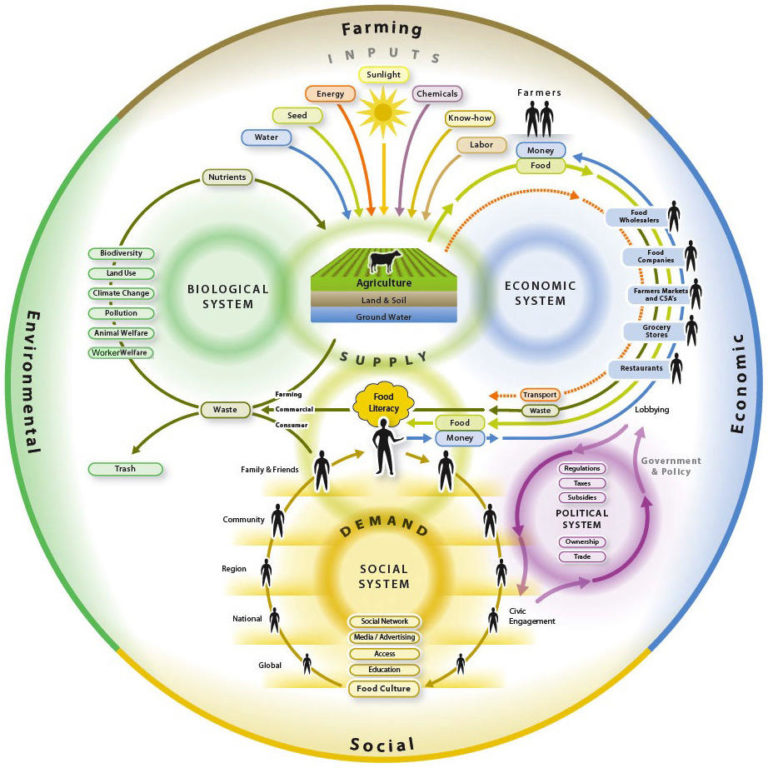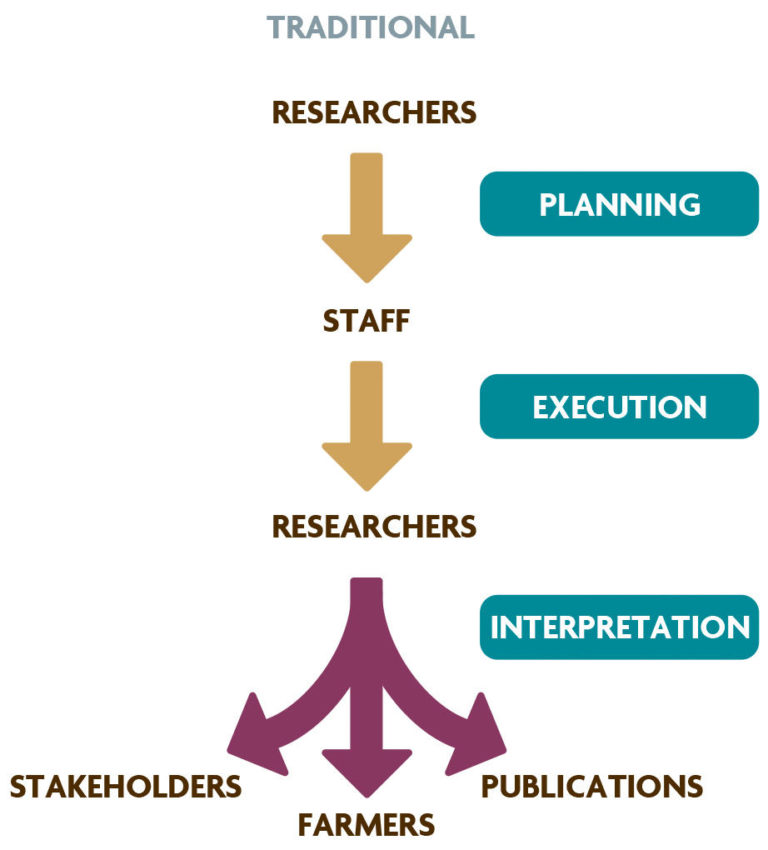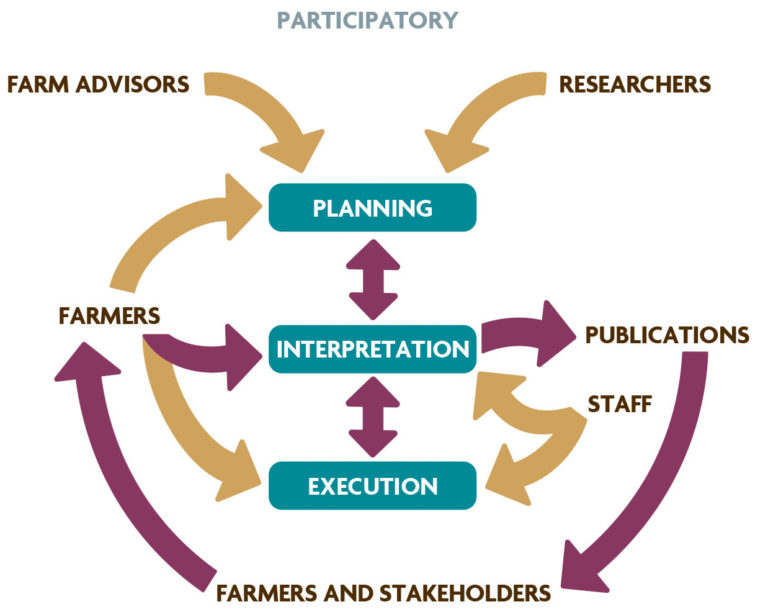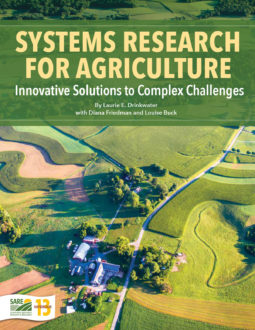We can’t solve problems by using the same kind of thinking as when we created them. —Albert Einstein
Agriculture in the United States is undergoing rapid transformation. Alongside production and economic pressures, farmers face a complicated suite of environmental goals such as protecting water and air resources, reducing agrochemical use, mitigating greenhouse gases and conserving biodiversity. In addition, many troublesome issues are directly linked to the dominant agricultural production system, including agrichemical runoff leading to dead zones and drinking water contamination, aquifer depletion, widely variable farm income, and loss of biodiversity.
To address these problems and also to create productive agricultural systems that protect the environment, provide sustainable income for farmers and help maintain healthy rural communities, agricultural research must be able to generate information that improves the whole farming system. Agricultural research must shift from measuring farm “performance” by single indicators such as yield and profit, to evaluating success using a multidimensional approach that incorporates the three dimensions of sustainability: environmental, social and economic.
A Whole-Farm System viewpoint incorporates all of the environmental and socioeconomic aspects of a farm, including the larger environmental and socioeconomic context in which it is embedded.
Systems research, holistic in nature and comprehensive in scope, is one such approach that can contribute to the development of agricultural systems that are environmentally, economically and socially viable while meeting production needs and addressing these systemic problems.
Systems research offers many benefits for agriculture and for society as a whole. By analyzing the complex interactions between farming practices and environmental and societal impacts, systems research can provide solutions and alternatives to these very problems while helping farmers maintain a sustainable livelihood. A systems approach also reaches beyond the individual field or farm to encompass the broader economy and environment, such as a rural community, watershed or county. Figure I.1 shows one model of an agricultural system. The graphic shows the components that comprise a food system, and the connections and relationships among those components. (See Chase and Grubinger [2014] for other viewpoints on agricultural and food systems.)

Because systems research can explore the mechanisms of entire agricultural systems, it frequently involves a diverse array of stakeholders such as producers, consumers, federal, state and local agencies, and extension agents. By integrating the expertise of these stakeholders, systems research teams can develop solutions that are applicable to real-world situations, and this approach often provides a wider range of innovative solutions compared to a single-discipline approach. Outside of research institutions, farmers continuously develop novel management systems that they share through farmer networks. By incorporating this wider knowledge base into the research process, participants learn from one another at all stages (Figure I.2).

Finally, systems approaches require that researchers from a variety of fields collaborate in designing and carrying out the research. Biological and environmental researchers join with sociological, political and economic experts to address factors such as the markets, laws and regulations that influence farmers’ decision-making processes. For example, much research on environmental concerns such as water contamination, soil degradation or loss of biodiversity has been conducted by biophysical and social scientists working separately. Solutions from biophysical scientists might emphasize changes in production practices, which often have limited success because they fail to account for socioeconomic factors. Likewise, policies based primarily on maximizing economic efficiency often do not reflect the environmental and climatic variability that farmers must respond to in managing their production systems.
Using a systems approach, researchers from these different disciplines join together to incorporate agronomic, ecological, economic and sociological theory. In doing so, they can develop a better understanding of how people make decisions and take action, and of how those actions affect yields, farm economics and the broader environmental, social and food systems.

Switching from single-outcome, reductionist research to systems research is not a simple proposition. This kind of shift involves major modifications of experimental designs and research protocols. Effective implementation of systems research requires researchers to take a different perspective on and approach to agricultural systems, scientific collaboration and experimental design, embracing substantial team effort and a crossing of disciplines, both of which are not the norms in university and research environments. Systems research also requires a significant time commitment, both in the short and long term. And finally, implementing a systems approach requires addressing institutional barriers, such as the lack of long-term funding for research and the promotion and tenure requirements for junior faculty.
However, as American agriculture continues to embrace sustainability, many of these barriers are shrinking. Practices that were considered fringe or alternative toward the end of the 20th century, such as cover cropping, integrated pest management and crop rotation, have been readily adopted by mainstream farmers. Market forces, such as those driven by consumer interest in organic and local foods, have become a main force in promoting farmer adoption of these and many other practices that emphasize sustainability. In response to widespread adoption of these approaches, many institutional research programs at the EPA and USDA now routinely incorporate sustainability and interdisciplinary systems approaches into their funding requirements. These programs, including the Organic Agriculture Research and Extension Initiative Program, the Organic Transitions Program, the Agriculture Food and Research Initiative, the Specialty Crop Research Initiative, the Agricultural Research Service and the Natural Resources Conservation Service provide further support for moving American agriculture toward more sustainable systems and the application of systems research (National Research Council, 2010). In its report Toward Sustainable Agricultural Systems in the 21st Century, the National Research Council (2010) calls for a transformative systems approach to modern agriculture, based on a systems approach, that involves integrating various research and extension disciplines and directing research toward innovative production systems that embody the goals of sustainability.
While not all scientific investigations can or should be conducted as large-scale, cross-disciplinary systems projects, even scientists whose research is narrower in scope can benefit from bringing a systems perspective to their work. Any line of inquiry is enhanced when researchers give thought to how their work fits into the larger context of agriculture, the environment and society.
As farmers continue down the path toward sustainability, as researchers incorporate systems thinking and approaches, and as the consumer-driven market presses for cleaner and healthier agriculture, systems research will continue to move to the forefront of the research agenda and help to develop new and vibrant systems for all of American agriculture. It is our hope that this book will contribute to that movement and discussion.
